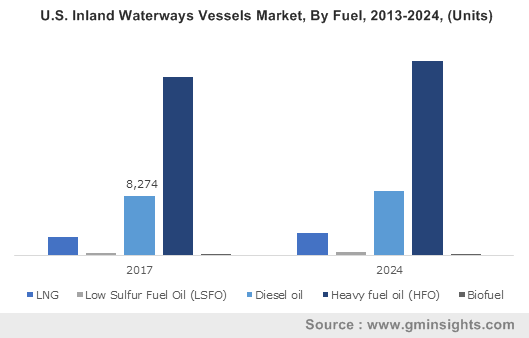APAC to dominate inland waterways vessel market over 2018-2024, increasing number of supportive initiatives by government bodies to augment the product demand
Publisher : Fractovia | Published Date : 2018-10-23Request Sample
With the swift acceptance of economical transportation systems, inland waterways vessel market has been gaining increasing popularity among the masses lately. Inland waterway transit is particularly in focus at present, as one of the most competitive alternatives for rail and road transport. This sudden spur of popularity can be principally attributed to the eco-friendly benefits of this mode of transport. Inland water ships ensure a high level of safety while carrying dangerous goods in addition to providing energy efficiency and reliability, thereby augmenting inland waterways vessel industry trends.
U.S. Inland Waterways Vessels Market, By Fuel, 2013-2024, (Units)

Recognizing the immense popularity of waterway transportation, regional governments have been on the go, encouraging the adoption of this mode of transportation. The European Union in fact has even come up with a set of regulatory norms to strengthen and promote inland waterways transportation systems. The increasing implementation of waterways transportation for conveyance of goods and passengers is thus likely to boost inland waterways vessel industry share.
Speaking of the involvement of government bodies, it would be prudent to mention a recent incidence witnessed across the Indian sub-continent. In 2017, the Gujarat state government, with the support of the Central government of India, commenced the Ro-Ro ferry services across Dahej and Ghogha for convenient intercity transportation. The initiative is expected to boost the economy of state with considerable savings of fuel and travel time. Indeed, the Ro-Ro ferry service is the debut inland waterway transportation across India and is evidence to the fact that the increasing adoption of this mode of transportation for enhancing business and regional trade is certain to stimulate inland waterways vessel market share.
Further elaborating on the Indian government’s initiatives to strengthen the regional inland waterways vessel industry trends, under the Jal Marg Vikas Project, the government of India is seemingly looking forward to developing the National Waterway 1. Through this project, the Inland Waterways Authority of India (IWAI) plans to provide an eco-friendly, economical, and safe mode of transportation to the Indian citizens. In order to accomplish the same, IWAI has inked a contract with the Germany-based vessel designing company, DST. IWAI has announced that it is going to procure approximately 60 vessels out of which 25 could be LNG fueled to facilitate transit via inland waterways. The procurement of vessels reportedly depends on the type of services like cargo and ferry. LNG vessels provide excellent operational efficiency and have a less hazardous influence on the environment, thereby augmenting LNF fueled inland waterways vessel market share. The aforementioned initiatives certainly imply that heavy investments in off-road transportation systems will have a remarkable influence on India inland waterways vessel market size.
Taking into account the increasing deployment of inland waterways for goods and passenger transportation, the regulatory bodies across numerous geographies have been enforcing suitable norms to ensure goods protection and safety of occupants. For instance, in 2017, the Singapore government mandated that vessels deployed in inland waterways would have to fulfill standards set by the Maritime and Port Authority of Singapore (MPA). The main aim behind implementing this new standard for inland waterway vessels was to set a safety benchmark the regional inland waterways vessel industry. The escalating involvement of various Asian countries such as India, South Korea, Singapore, and China in waterway infrastructure development will thus substantially expedite Asia Pacific inland waterways vessel industry outlook.
As per Global Market Insights, Inc., APAC inland waterways vessel market size was pegged at USD 1200 billion in 2017 and will exceed USD 1700 billion by 2024, driven by the expanding tourism industry and the rising number of trade activities in the region.
Since the last few decades, the inland waterway transportation network has grown tremendously across Europe, stimulating the regional inland waterways vessel market size. Indeed, this mode of transportation has helped connect European countries to the Baltic Sea, Coastal North Sea, and Black Sea. Despite a well-developed rail and road transportation network, waterway transit has achieved more popularity across Europe pertaining to the lesser transportation cost.
Incidentally, numerous cities and industrial areas across Europe are connected to each other via waterways spanning 37,000 km. Out of 28 EU member states, 13 have been interconnected through inland waterways. Thus, considering the growing deployment of inland waterway vessels, in 2017, the EU drafted a few regulatory norms with regards to vessels production, deployment, and navigation. Such directives have apparently helped EU member states set up efficient and safe waterway transportation systems across their regional landscape. As per the most recently recent directive, sailors should possess a specific authorization for operating on LNG fueled ships and large conveyors. With the deployment of such strict safety directives, Europe inland waterways vessel market has been witnessing significant growth lately.
The robust development and expansion of inland waterways for cost-effective trading and transportation is poised to have a considerable impact on inland waterways vessel industry size. Many regional governments, specifically the ones rooted across the Asian zone, are now becoming more and more aware of the economic benefits of deploying inland waterway vessels, which could enhance the product demand over the years ahead. Driven by extensive investments in off-road infrastructure development and the increasing proportion of waterway trade activities, inland waterways vessel market outlook is expected to undergo a dynamic transformation over 2018-2024.